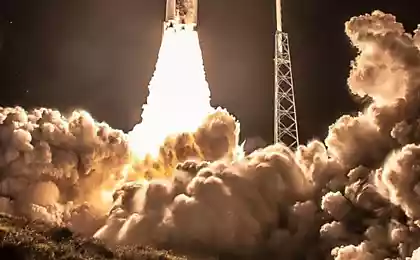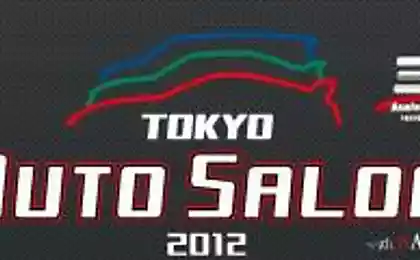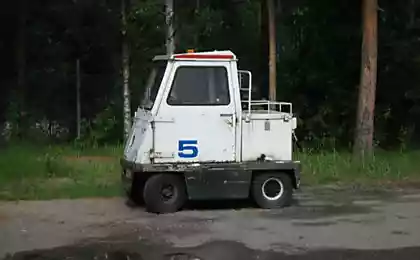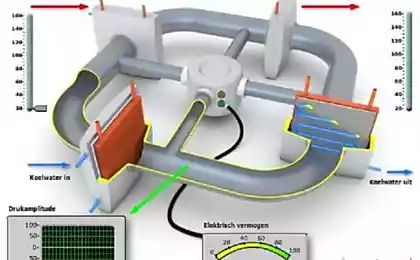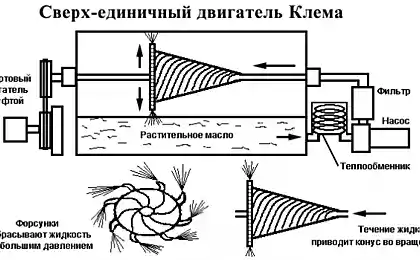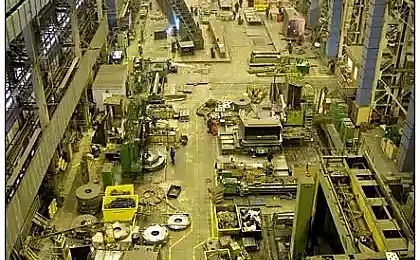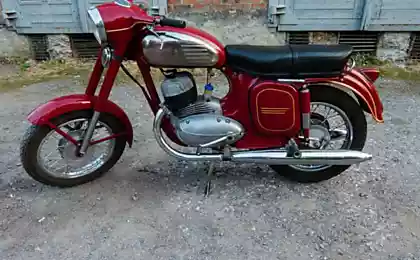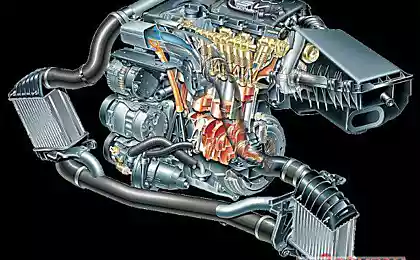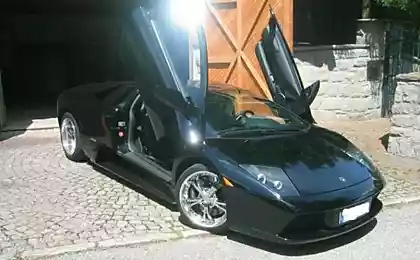650
The case will determine the future
For general education purposes.
A small selection of scientists accidentally gave the world useful Soup (7 photos)
Frank Epperson - Popsicle stick
Frank Epperson, the author of the invention, a young guy was just eleven years old when came up with what some would later be called one of the most important inventions of the 20th century. Of course, probably Lady Luck smiled at the boy, when he dissolved soda powder into the water - a popular drink rebyatni 1905. Drink just will not work, and Frank is not removed from the glass rod to stir the drink, put down it for a while. The weather was freezing and the mixture is frozen. Frank laughingly showed his classmates ridiculous contraption frozen on a stick that could be licking tongue. After 18 years, Frank remembered this fun event and began to produce popsicles «Epsicles» in seven variations of flavors. Today, only in America in the year it sold more than three million popsicle stick.

George de Mestrel - Velcro
In 1941 a Swiss inventor George de Mesrel walking his dog. When they returned home, it turned out that the coat George, as well as the dog's fur were covered with brambles. Having considered the bur under a microscope, George considered, hooks, which the plant is attached to the dog's coat just is not "firmly».
He fashioned two tapes with the same small hooks that cling to each other - alternative closure has turned out! But the mass production of "sticky" will come only after 14 years. The first to adopt them took astronauts - they buttoned suits.
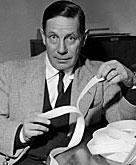
Gary Hoover - Superglue
Superglue, or Crazy Glue, a substance that is actually called «cyanoacrylate (cyanoacrylate)" It was invented by accident by Gary Hoover, who in laboratory conditions during the Second World War (1942) to search for clear plastic gun sights. The resulting cyanoacrylate decided his problems as quickly hardened, Jell what got spoiled and laboratory equipment.
But many years later, in 1958, he realized that his invention could do a favor to humanity. The most real benefit was the ability to instantly seal the wound - it saved the lives of many soldiers during the Vietnam War - with taped wounds they can be transported to the hospital. By the way, in 1959, the extraordinary ability of the adhesive has been demonstrated America when the anchor was hoisted into the air by means of two steel plates glued together only a drop of glue. Later in the air rises in a row - from TVs to car

Spencer Silver - Adhesive sheets - memostikersy
In 1970, Spencer Silver, who worked for a corporation 3M (Minnesota, Mining and Manufacturing), tried to develop a super-strong glue. The fact that he managed to get was the exact opposite: the adhesive smeared on the surface of the paper, and if it stuck to something, she fell off after some time without leaving any traces on the surface.
Four years later, an employee of the same company, Arthur Fry, who sang in the church choir, to quickly find the desired text, invented the glue tabs to the book with psalms, smeared with the composition - or they will easily fall out of it. Since 1980 - the beginning of release memostikerov - to this day - this is one of the most popular office products. Edouard Benedictus - Safety glass
Today it is known everywhere, but when the French scientist Edouard Benedictus in 1903 while working in the laboratory accidentally dropped on the floor empty glass flask and it is not broke - it was very surprised. The walls of the flask, of course, have been covered with a mesh of cracks, but it is not broken pieces. It was found that in the flask until the solution was kept collodion (cellulose nitrate dissolved in ethanol-ethyl ether) solution was evaporated, but the walls of the vessel were covered with a thin layer.
While in France developed automobile, the windshield was made of ordinary glass - it was the cause of many injuries of drivers. Benidikuts saw a real benefit for saving many lives in the use of his invention in the car, but automakers have considered it too expensive to manufacture. Only years later, after WW 1 was used as a laminated glass for gas masks, 1944 Volvo apply it in cars.
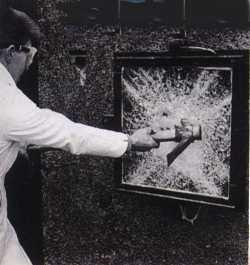
Charles Goodyear - Vukanizirovannaya tires
When Columbus brought the first rubber balls from the West Indies, it was like a magical discovery. But it has been a miracle and cons: rubber, rotten, stinking, too sticky in the heat - and too hard when cold. So people did not understand at the time, where it can be applied. Almost 300 years later - in 1839 - Charles Goodyear has solved this problem. Its chemical laboratory he tried to mix the rubber with magnesia, lime, nitric acid - all in vain. Next try - to mix the rubber with sulfur also ended in failure. But suddenly, quite by chance, these dropped rubber and sulfur on a hot stove - that was so obtained solid rubber from which are now producing balls, rubbers and tires.

William Rengen - X-rays and X- Rays
These rays were discovered in 1895 by physicist William Rengenom. He worked in a darkened room, trying to figure out whether the newly discovered cathode rays not (they are applied so far - in television, in fluorescent lamps, etc.) to pass through a vacuum tube or not. By chance he noticed on chemically cleaned the screen at a distance of a few feet appeared fuzzy greenish cloud. It was like that, as if faint flash from the induction coil is reflected in the mirror. Seven weeks later, he conducted research, practically without leaving the lab. It turned out that the cause of the glow is the direct rays emanating from the cathode ray tube, the radiation gives a shadow, and it can not be dismissed with a magnet - and much more. As it became clear that human bones cast shadows denser than the surrounding soft tissue that still is used in fluoroscopy. And the first x-ray film appeared in 1895 - it was a picture of Madame X-ray of the hand with the golden ring clearly distinguished. So it is the first time the man saw the woman "through" and not vice versa. Alexander Fleming - Penicillin
Alexander Fleming discovered penicillin in 1928. In fact, he was not looking for it at the time, but simply examined the flu. He was not very much care to washing glassware immediately after the experiment, and do not dispose of culture flu for 2-3 weeks in a row, accumulating on your desktop for 30-40 cups simultaneously. So, once he is in a petri dish I found mold, which, to his surprise, suppressed seeded culture staph bacteria. Mould, which turned out to be infected with culture, belonged to a very rare sight. Rather, it has been brought from the laboratory located on the floor below, where they grow mold samples taken from the homes of patients suffering from bronchial asthma. Fleming left which later became the famous cup on the bench and left to rest. There will come a cold snap in London has created favorable conditions for the growth of mold, and then will come warming - for bacteria. As it turned out later confluence of these circumstances was obliged famous discovery - not only of the 20th century - penicillin, saved and saving still life and health of the incredible number of people. When Fleming died, he was buried in the Cathedral of St. Paul's in London - close to the most revered British, while in Greece the day of his death was declared a national mourning.
Source:
A small selection of scientists accidentally gave the world useful Soup (7 photos)
Frank Epperson - Popsicle stick
Frank Epperson, the author of the invention, a young guy was just eleven years old when came up with what some would later be called one of the most important inventions of the 20th century. Of course, probably Lady Luck smiled at the boy, when he dissolved soda powder into the water - a popular drink rebyatni 1905. Drink just will not work, and Frank is not removed from the glass rod to stir the drink, put down it for a while. The weather was freezing and the mixture is frozen. Frank laughingly showed his classmates ridiculous contraption frozen on a stick that could be licking tongue. After 18 years, Frank remembered this fun event and began to produce popsicles «Epsicles» in seven variations of flavors. Today, only in America in the year it sold more than three million popsicle stick.

George de Mestrel - Velcro
In 1941 a Swiss inventor George de Mesrel walking his dog. When they returned home, it turned out that the coat George, as well as the dog's fur were covered with brambles. Having considered the bur under a microscope, George considered, hooks, which the plant is attached to the dog's coat just is not "firmly».
He fashioned two tapes with the same small hooks that cling to each other - alternative closure has turned out! But the mass production of "sticky" will come only after 14 years. The first to adopt them took astronauts - they buttoned suits.

Gary Hoover - Superglue
Superglue, or Crazy Glue, a substance that is actually called «cyanoacrylate (cyanoacrylate)" It was invented by accident by Gary Hoover, who in laboratory conditions during the Second World War (1942) to search for clear plastic gun sights. The resulting cyanoacrylate decided his problems as quickly hardened, Jell what got spoiled and laboratory equipment.
But many years later, in 1958, he realized that his invention could do a favor to humanity. The most real benefit was the ability to instantly seal the wound - it saved the lives of many soldiers during the Vietnam War - with taped wounds they can be transported to the hospital. By the way, in 1959, the extraordinary ability of the adhesive has been demonstrated America when the anchor was hoisted into the air by means of two steel plates glued together only a drop of glue. Later in the air rises in a row - from TVs to car

Spencer Silver - Adhesive sheets - memostikersy
In 1970, Spencer Silver, who worked for a corporation 3M (Minnesota, Mining and Manufacturing), tried to develop a super-strong glue. The fact that he managed to get was the exact opposite: the adhesive smeared on the surface of the paper, and if it stuck to something, she fell off after some time without leaving any traces on the surface.
Four years later, an employee of the same company, Arthur Fry, who sang in the church choir, to quickly find the desired text, invented the glue tabs to the book with psalms, smeared with the composition - or they will easily fall out of it. Since 1980 - the beginning of release memostikerov - to this day - this is one of the most popular office products. Edouard Benedictus - Safety glass
Today it is known everywhere, but when the French scientist Edouard Benedictus in 1903 while working in the laboratory accidentally dropped on the floor empty glass flask and it is not broke - it was very surprised. The walls of the flask, of course, have been covered with a mesh of cracks, but it is not broken pieces. It was found that in the flask until the solution was kept collodion (cellulose nitrate dissolved in ethanol-ethyl ether) solution was evaporated, but the walls of the vessel were covered with a thin layer.
While in France developed automobile, the windshield was made of ordinary glass - it was the cause of many injuries of drivers. Benidikuts saw a real benefit for saving many lives in the use of his invention in the car, but automakers have considered it too expensive to manufacture. Only years later, after WW 1 was used as a laminated glass for gas masks, 1944 Volvo apply it in cars.

Charles Goodyear - Vukanizirovannaya tires
When Columbus brought the first rubber balls from the West Indies, it was like a magical discovery. But it has been a miracle and cons: rubber, rotten, stinking, too sticky in the heat - and too hard when cold. So people did not understand at the time, where it can be applied. Almost 300 years later - in 1839 - Charles Goodyear has solved this problem. Its chemical laboratory he tried to mix the rubber with magnesia, lime, nitric acid - all in vain. Next try - to mix the rubber with sulfur also ended in failure. But suddenly, quite by chance, these dropped rubber and sulfur on a hot stove - that was so obtained solid rubber from which are now producing balls, rubbers and tires.

William Rengen - X-rays and X- Rays
These rays were discovered in 1895 by physicist William Rengenom. He worked in a darkened room, trying to figure out whether the newly discovered cathode rays not (they are applied so far - in television, in fluorescent lamps, etc.) to pass through a vacuum tube or not. By chance he noticed on chemically cleaned the screen at a distance of a few feet appeared fuzzy greenish cloud. It was like that, as if faint flash from the induction coil is reflected in the mirror. Seven weeks later, he conducted research, practically without leaving the lab. It turned out that the cause of the glow is the direct rays emanating from the cathode ray tube, the radiation gives a shadow, and it can not be dismissed with a magnet - and much more. As it became clear that human bones cast shadows denser than the surrounding soft tissue that still is used in fluoroscopy. And the first x-ray film appeared in 1895 - it was a picture of Madame X-ray of the hand with the golden ring clearly distinguished. So it is the first time the man saw the woman "through" and not vice versa. Alexander Fleming - Penicillin
Alexander Fleming discovered penicillin in 1928. In fact, he was not looking for it at the time, but simply examined the flu. He was not very much care to washing glassware immediately after the experiment, and do not dispose of culture flu for 2-3 weeks in a row, accumulating on your desktop for 30-40 cups simultaneously. So, once he is in a petri dish I found mold, which, to his surprise, suppressed seeded culture staph bacteria. Mould, which turned out to be infected with culture, belonged to a very rare sight. Rather, it has been brought from the laboratory located on the floor below, where they grow mold samples taken from the homes of patients suffering from bronchial asthma. Fleming left which later became the famous cup on the bench and left to rest. There will come a cold snap in London has created favorable conditions for the growth of mold, and then will come warming - for bacteria. As it turned out later confluence of these circumstances was obliged famous discovery - not only of the 20th century - penicillin, saved and saving still life and health of the incredible number of people. When Fleming died, he was buried in the Cathedral of St. Paul's in London - close to the most revered British, while in Greece the day of his death was declared a national mourning.
Source:




